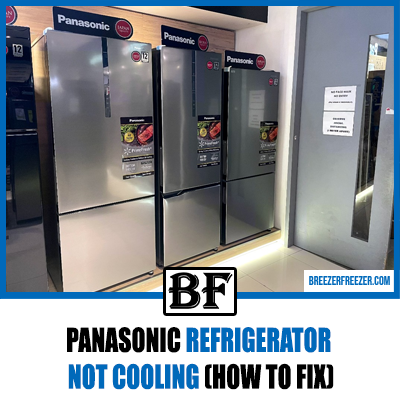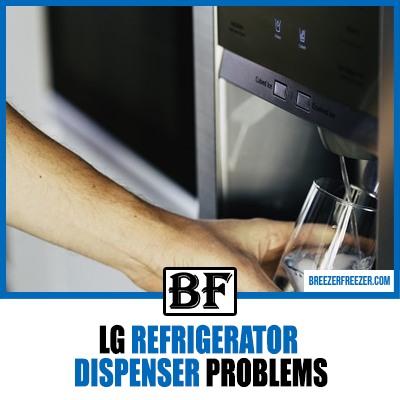GE Refrigerator Error
What’s better than enjoying ice cream on a hot summer’s day, taking a scoop of your favorite flavor in the comfort of home?

Not much, right? So, you’ll agree that it’s equally frustrating when the ice cream melts into a tasteless soup, despite putting it in the freezer hours back.
If you have a GE refrigerator, then you probably missed the error code flashed and are wondering what to do next. While it may be too late to save the ice cream, you can troubleshoot the problem to ensure that other food items don’t deteriorate.
That’s why this guide will tell you what to do when your GE refrigerator flashes an error code.
GE Refrigerator Error Code
Do you have a hankering for spaghetti and sliced-up hot dogs? Then, take it out of the GE fridge and cook up a sumptuous dinner.
Wait, what’s that? Your GE refrigerator is malfunctioning, and all you see are some codes on the screen.
Don’t worry; you don’t have to “break the code” like Benedict Cumberbatch in The Imitation Game to get the fridge working again. This is a classic case of your GE refrigerator encountering some common issues, owing to which error codes appear on the screen.
Luckily, it’s not our first time helping people with GE refrigerator error codes. In fact, it’s pretty easy to resolve the issues when you know what to do.
But first, let’s look at some common error codes and see what they mean.
Common GE Refrigerator Error Codes
Did you know that your GE refrigerator can speak? Well, not exactly, but it can communicate, and before you call us crazy and stop reading the rest of this guide, let us explain.
A GE refrigerator being a modern appliance reduces the need for manual labor. So, gone are the days when you would have to poke around the wires to locate a problem. Nowadays, the fridge tells you exactly what’s wrong, allowing a smooth diagnosis.
1. HRS Error Code
This error code reveals that the GE refrigerator is stuck in the defrost cycle, preventing the ice maker from cooling, causing frozen food to go bad. It would be best to check the main control board and the wire harness to ensure they are in working order in such a scenario.
We suggest replacing them if you notice any problems. But don’t be hasty; start by resetting the error codes using the system key because if that doesn’t work and the codes reappear, it points to system failures.
In layman’s terms, the GE refrigerator has a defective part, which you must pinpoint and replace swiftly.
2. PF Code
When the PF code appears, it refers to a power failure, and you should check the power supply to the GE refrigerator. Usually, the simplest thing would be to make sure that the wall outlet and the power cord are in working condition. Because if they aren’t, you need to contact a service technician to replace the loose wires and damaged components.
3. E2 Error Code
The E2 error code is pretty easy to understand, as, more often than not, there’s a problem with the main control board. Unfortunately, you can’t fix it yourself and will have to contact a repair technician to locate and solve the problem or possibly change the board.
4. DE Error Code
If you see the DE code, it means that the defrost system on the GE refrigerator hasn’t been activated in the past 48 hours. As most modern fridges have a defrost timer, you can check the defrost circuit to determine what’s wrong.
But, in case that seems too difficult, simply unplug the fridge and check for loose wires before plugging it in. You can usually tell when the wire harness has gone bad or use a multimeter to test the electronic control board and subsequent components for other system failures.
Not to mention, replace all worn-out components for proper operation to prevent spoiled food. After all, spaghetti bolognese tastes best with some wine, not when it’s smelly.
5. DF Error Code
Due to a power outage, the defrost circuit experiences fluctuations in the electric supply, which hinders the usual functioning of the GE refrigerator. As a result, it either remains stuck in the defrost cycle or fails to activate the defrost system automatically.
To ensure that the different components are functioning properly, you can use a multimeter to test them, including the defrost heater, thermostat, and timer. If not, you should replace the faulty ice maker components and contact a professional service.
6. FF Code
Did you activate the turbo freeze option a couple of days back but are now unable to alter the freezer temperature? This happens when the screen displays the FF function code, rendering the temperature controls inactive.
Effectively, the interior temperatures of the refrigerator and freezer compartments keep rising, causing frozen food items to thaw. No longer will the spaghetti smell because it’s likely to turn into an icicle!
The first thing you should do is check the condition of the frozen foods and close the freezer doors. Moreover, the door gaskets should form a tight seal to melt the ice mold and clear jammed ice cubes from the tray.
Also, don’t open the refrigerator and freezer doors frequently, allowing the internal temperature to drop. Meanwhile, try to reset the function codes by pressing the system key.
7. CI Error Code
Often the GE refrigerator flashes a CI code, referring to the cooling system malfunctioning. You can check the ice mold to see if it’s filling with water, for starters. In case it isn’t, try turning the water supply off and back on while also clearing the ice cubes jammed into the tray.
But be careful when shutting down the GE refrigerator because you’ll have to turn off the water. Following this, press the system key to override the fault codes; that said, if the CI code reappears, your only option is to change the ice maker assembly.
8. CC Error Code
Another code you should be aware of is the CC fault code, whereby the temperature set for the GE refrigerator isn’t right. The temperature inside the freezer keeps rising, and to prevent this, you need to adjust the temperature display controls accordingly.
If you’re confused, check the user manual as it carries all the information. What’s more, look closely at the condition of the gasket and close the freezer doors completely.
In case you feel that certain components need replacing, do so by all means before pressing the system key to clear the error code.
Some Other GE Refrigerator Error Codes
These are some lesser-known error codes, so we have categorized them separately, explaining what each code stands for.
1. Error Code SA 66
Technically, this isn’t an error code but means that the GE refrigerator has gone into the Sabbath mode. All you need to do is to long-press the light and lock keys for 3 seconds to exit the mode. But depending on the GE refrigerator model, you may have to press the alarm button instead of the light key.
2. Error Code 88/89
When the screen displays error codes 88 or 89, it usually means that a sudden power surge may have burnt the electronic control board. You can perform a simple diagnosis by unplugging the GE refrigerator from the electrical outlet and letting the unit rest for 5 minutes.
Then, plug it in again to check if the ice maker is working as usual, or you’ll have to replace the board and control panel.
3. 0000 Error Code
When the GE refrigerator error code flashes the digits “0000”, you should know that there’s an issue with the motherboard or the main control board. Instead of jumping to conclusions and fixing it yourself, call a professional to look at the system.
They will tell you where the problem lies and help replace it with a new component.
4. Water Filter Error
If the screen displays a water filter error message, it’s time to change the water filter, especially when you haven’t done so in a long time. Luckily, it’s easy to purchase a relevant water filter and replace the old model with it. Also, remember to reset the GE refrigerator by pressing the water and ice buttons, on the control panel, for 3 seconds.
5. EF Error Code
At times, the ice maker displays the error code “EF,” which is, in fact, a display error, and we think that it actually stands for “tF.” Most people are left confused when they can’t find the error code in the user manual because they mistake the “t” for an incomplete “E” or an upside-down “f.”
Long story short, it refers to turbo freeze, and you can just change the GE refrigerator settings since it’s not an error code.
6. tC Error Code
Similar to the previous “fake error code,” the terms “tC” refer to turbo cool, which consumers can enable when they want to cool the GE fridge quickly. Again, it’s just a refrigerator setting that you can change without troubleshooting the problem or resetting the system.
Another thing you should note is that “tC” looks very much like “EC,” so don’t be confused. Instead, note that it mostly activates when there’s hot food inside the refrigerator, or you have left the freezer door open for too long.
7. Lc Er Error Code
The Lc Er error code points to a communication breakdown between the integrated circuit chips and the main control board of the GE refrigerator. However, there’s no need to panic because the unit alerts you when the system has been non-functional for at least 20 seconds.
Unfortunately, though the GE refrigerator error code alerts you soon enough, the only solution is to replace the main control board by seeking professional help.
Components Affected By Error Codes
We have discussed the major error codes that you can encounter when operating a GE refrigerator, but our guide doesn’t end here. We will also tell you about the components that are regularly impacted by a faulty system and why you should replace them quickly.
1. Evaporator Fan Motor
For those who are unaware, the evaporator fan sucks cool air released by the evaporator coils, using it to cool the freezer. Naturally, if the fan is broken, it fails to cool the refrigerator adequately, and the freezer compartment becomes warm.
2. Condenser Fan
The functions of the condenser fan are slightly different as it draws cold air through the condenser coils to cool the GE refrigerator. Often lack of maintenance leads to dirty condenser coils, or there might be some obstruction, preventing the fan blades from operating smoothly. As a result, the ice maker fails to cool, necessitating the need to replace a faulty fan motor.
3. Water Pressure And Inlet Valve
Maintenance is crucial to ensure that the refrigerator is in top condition, and one of the key aspects is cleaning the water filters. It would be best to replace the filters after six months and test the water pressure. Ideally, the pressure should be 20 PSI because anything lower will not allow the ice maker to fill.
Similarly, another essential component is the water inlet valve that electronically supplies water to the fridge. A defective valve will prevent water from filling the ice trays, making it a crucial component that needs maintenance.
Final Words
With that, it’s a wrap on today’s guide about GE refrigerator error codes; hopefully, you now have a better idea about what each code stands for.
This article promises to be a detailed reference, helping you understand the problem and find a quick solution.
However, do remember to contact a professional company to replace damaged parts or call customer care instead of taking matters into your own hands. This will prevent further damage to the fridge, guaranteeing a smooth resolution.



![Whirlpool Refrigerator Error [Solved]](https://breezerfreezer.com/wp-content/uploads/2022/08/Whirlpool-Refrigerator-Error-Solved.png)

